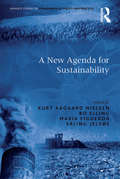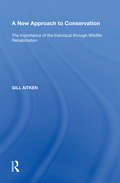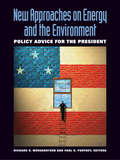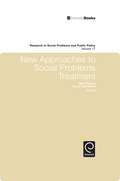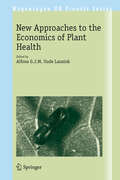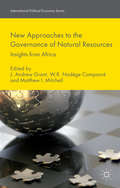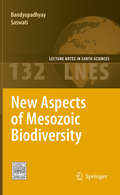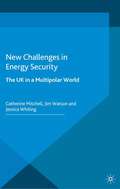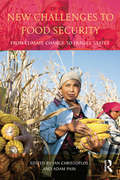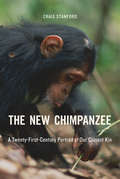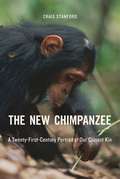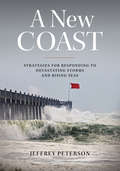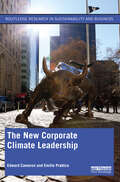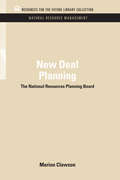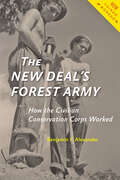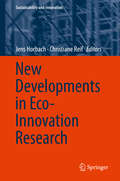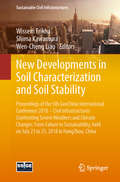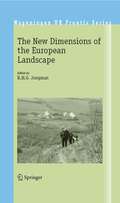- Table View
- List View
A New Agenda for Sustainability (Routledge Studies in Environmental Policy and Practice)
by Bo Elling Erling JelsøeTwo decades after the Brundtland Commission's Report "Our Common Future" adopted the concept of 'sustainable development', this book provides a renewal of the concept exploring the potential for new practices and fields for those involved in sustainability activity. The book addresses a number of themes concerning firstly, the provision of a "next generation perspective", which was a central, and still unresolved, notion of the original Brundtland definition and, secondly the provision of new milestones for policy and research that can expand the discussion on this second generation concept on sustainability. The material dealt with in the book offers a wide variety of perspectives on sustainability and reflects the importance of interdisciplinary and transdiciplinary work in the field. Suggesting targets for future analytical and political efforts in achieving global sustainability, this book offers new analytical opportunities for holistic politics and research at a general and sector level.
A New Approach to Conservation: The Importance of the Individual through Wildlife Rehabilitation
by Gill AitkenConservationists assume a set of underlying values which guide their decision-making and action. The safeguarding or promotion of biodiversity, it is believed, is the means by which nature is best protected. This book examines - and challenges - these general conservation assumptions. While reinforcing the need to halt extinction and value biodiversity, it shows that biodiversity needs to be more clearly understood, perhaps being replaced by the notion of 'wildness'. It examines how biodiversity is a holistic term, and how individual species need to be assessed and their own contribution to 'wildness' has to be recognized. The book proposes a new way of conservation - one which makes more room for neglected, rather than endangered or rare species. It also asserts that 'wildness' is not incompatible with certain kinds of human intervention.
A New Approach to Conservation: The Importance of the Individual through Wildlife Rehabilitation
by Gill AitkenConservationists assume a set of underlying values which guide their decision-making and action. The safeguarding or promotion of biodiversity, it is believed, is the means by which nature is best protected. This book examines - and challenges - these general conservation assumptions. While reinforcing the need to halt extinction and value biodiversity, it shows that biodiversity needs to be more clearly understood, perhaps being replaced by the notion of 'wildness'. It examines how biodiversity is a holistic term, and how individual species need to be assessed and their own contribution to 'wildness' has to be recognized. The book proposes a new way of conservation - one which makes more room for neglected, rather than endangered or rare species. It also asserts that 'wildness' is not incompatible with certain kinds of human intervention.
New Approaches on Energy and the Environment: Policy Advice for the President
by Richard D. Morgenstern Paul R. PortneyWritten by economists and policy analysts at Resources for the Future, a Washington, DC, think tank with a tradition for independent, objective research, this collection of twenty-five 'memos to the President' offers constructive policy options for the elected administration on critical challenges related to energy, the environment, and natural resources. Each contributor to New Approaches on Energy and the Environment was asked to address the question: 'Based on your research and knowledge, what policy recommendation would you like to make to the next U.S. president?' Writing in advance of the 2004 election so as to keep their essays free of partisan interpretations, the authors were asked not to confine their suggestions to what the prevailing wisdom says is politically possible. They also took pains to make their ideas accessible to a busy president as well as a wide range of readers interested in a concise and authoritative overview of the nation's energy and environmental policy choices. The results are provocative, sometimes controversial, but highly readable essays on topics including climate change, oil dependency, electricity regulation, brownfields revitalization, forest service administration, air and water quality, and environmental health issues such as food safety and the growing threat of antibiotic resistance. When the President takes office in January, 2005, he will confront competing perspectives about the priorities and approaches that should apply to energy and environmental policy: Americans want cleaner air and water and healthy and attractive surroundings, but they also want inexpensive fuel, comfortable cars and houses, and continued economic growth. New Approaches on Energy and the Environment provides thought-provoking, commonsense contributions to debates about important energy and environmental issues confronting the U.S. today.
New Approaches on Energy and the Environment: Policy Advice for the President
by Richard D. Professor Morgenstern Paul Professor PortneyWritten by economists and policy analysts at Resources for the Future, a Washington, DC, think tank with a tradition for independent, objective research, this collection of twenty-five 'memos to the President' offers constructive policy options for the elected administration on critical challenges related to energy, the environment, and natural resources. Each contributor to New Approaches on Energy and the Environment was asked to address the question: 'Based on your research and knowledge, what policy recommendation would you like to make to the next U.S. president?' Writing in advance of the 2004 election so as to keep their essays free of partisan interpretations, the authors were asked not to confine their suggestions to what the prevailing wisdom says is politically possible. They also took pains to make their ideas accessible to a busy president as well as a wide range of readers interested in a concise and authoritative overview of the nation's energy and environmental policy choices. The results are provocative, sometimes controversial, but highly readable essays on topics including climate change, oil dependency, electricity regulation, brownfields revitalization, forest service administration, air and water quality, and environmental health issues such as food safety and the growing threat of antibiotic resistance. When the President takes office in January, 2005, he will confront competing perspectives about the priorities and approaches that should apply to energy and environmental policy: Americans want cleaner air and water and healthy and attractive surroundings, but they also want inexpensive fuel, comfortable cars and houses, and continued economic growth. New Approaches on Energy and the Environment provides thought-provoking, commonsense contributions to debates about important energy and environmental issues confronting the U.S. today.
New Approaches to Social Problems Treatment (Research in Social Problems and Public Policy #17)
by Stacy Lee Burns Mark PeyrotThis volume examines diverse developments in the evolution of public policy institutions for remedying social problems. The collected chapters address the transformation of social problems, social problems work, and social problems solutions in the context of criminal justice, mental health, and community institutions (schools) in contemporary society. These diverse settings and institutions collectively reflect a trend toward the use of various 'treatment' initiatives within formal disciplinary systems and as part of legalistic social control strategies. Although all of the remedial approaches considered are 'new' in the sense of being recent innovations, many are only the most recent in a long sequence of policy initiatives. The contributors to the collection demonstrate that recent transformations in remedial approaches to social problems and the challenges faced by such policy initiatives are as much a function of what has come before as they are of their own inherent features.
New Approaches to the Economics of Plant Health (Wageningen UR Frontis Series #20)
This book presents the outcomes of a workshop around the emerging area of the economics of plant health. The workshop was organized in Wageningen in July 2005 under the auspices of Frontis – Wageningen International Nucleus for Strategic Expertise. Plant health nowadays plays an increasing role in national and international policy making. This explains the interest of the Netherlands Ministry of Agriculture, Nature and Food Quality in this workshop. The increasing importance of plant health in international policy making also follows from the recent establishment of a scientific panel on plant health by the European Food Safety Authority. This panel has to advise the EU on policy issues in the area of plant health. Plant health issues have numerous economic dimensions. Measures to control quarantine diseases and invasive species are usually costly, whereas the potential benefits, e. g. , avoided losses, are often difficult to quantify. Quantifying the costs and benefits requires close collaboration between economists and epidemiologists. New GIS tools can play an important role in visualizing and modelling the combined economic and epidemiological consequences of control measures. Quarantine organisms and invasive species also frequently have impacts that go beyond agriculture. Impacts on landscapes and the environment call for the application of new approaches to measuring the economic impacts on society. This book presents a number of new approaches to economic modelling of plant health; it is primarily intended for policy makers and scientists working in the area of plant health.
New Approaches to the Governance of Natural Resources: Insights from Africa (International Political Economy Series)
by J. Andrew Grant W.R. Nad�ge Compaor� Matthew I. MitchellThe book provides an in-depth analysis of the governance of Africa's natural resource sectors (oil, biofuels, forestry, fisheries, minerals) and new insights for readers as they navigate the burgeoning research on global governance initiatives and regional/national strategies that seek to improve the governance of the continent's natural resources.
New Aspects of Mesozoic Biodiversity (Lecture Notes in Earth Sciences #132)
by Saswati BandyopadhyayThe Indian Statistical Institute (ISI) was established on 17th December, 1931 by a great visionary Prof. Prasanta Chandra Mahalanobis to promote research in the theory and applications of statistics as a new scienti c discipline in India. In 1959, Pandit Jawaharlal Nehru, the then Prime Minister of India introduced the ISI Act in the parliament and designated it as an Institution of National Importance because of its remarkable achievements in statistical work as well as its contribution to economic planning. Today, the Indian Statistical Institute occupies a prestigious position in the a- demic rmament. It has been a haven for bright and talented academics working in a number of disciplines. Its research faculty has done India proud in the arenas of Statistics, Mathematics, Economics, Computer Science, among others. Over s- enty ve years, it has grown into a massive banyan tree, like the institute emblem. The Institute now serves the nation as a uni ed and monolithic organization from different places, namely Kolkata, the Headquarters, Delhi, Bangalore, and Chennai, three centers, a network of ve SQC-OR Units located at Mumbai, Pune, Baroda, Hyderabad and Coimbatore, and a branch ( eld station) at Giridih. The platinum jubilee celebrations of ISI have been launched by Honorable Prime Minister Prof. Manmohan Singh on December 24, 2006, and the Govt. of India has declared 29th June as the “Statistics Day” to commemorate the birthday of Prof. Mahalanobis nationally.
New Botanical Painting
by Harriet de WintonAward-winning artist Harriet de Winton shows you how to create contemporary watercolour artworks to treasure and share. Through more than 30 step-by-step projects, discover how to paint individual flowers and foliage, as well as beautiful botanical compositions. Use your new skills to make art for your wall, unique cards, invitations, or simply paint for pleasure.
New Challenges in Energy Security: The UK in a Multipolar World (Energy, Climate and the Environment)
by Catherine Mitchell, Jim Watson and Jessica WhitingResearchers and practitioners explore the effect of evolving global economic and political powers on energy security within the UK and puts forward practical options for moving towards a more energy secure system over both the short and long terms.
New Challenges to Food Security: From Climate Change to Fragile States
by Ian Christoplos Adam PainFood security is high on the political agenda. Fears about societal insecurity due to food price increases and hunger, grave scenarios regarding the effects of climate change and general uncertainty about the impacts of investments in biofuels and so-call “land grabbing” on food prices and availability have meant that food security is now recognised as being a multifaceted challenge. This book is unique in that it will bring together analyses of these different factors that impact on food security. This volume will describe a range of different perspectives on food security, with an emphasis on the various meanings that are applied to food security “crisis”. The challenges to be reviewed include market volatility, climate change and state fragility. Analyses of responses to food security crises and risk will cover rural and urban contexts, arenas of national policy formation and global food regimes, and investment in land and productive technologies. This book is unique in two respects. First, it takes a step back from the normative literature focused on specific factors of, for example, climate change, agricultural production or market volatility to look instead at the dynamic interplay between these new challenges. It helps readers to understand that food security is not one discourse, but is rather related to how these different factors generate multiple risks and opportunities. Second, through the case studies the book particularly emphasises how these factors come together at local levels as farmers, entrepreneurs, consumers, local government officials and others are making key decisions about what will be done to address food security and whose food security will be given priority. The book will explore how food production and consumption is embedded in powerful political and market forces and how these influence local actions.
New Challenges to Food Security: From Climate Change to Fragile States
by Ian Christoplos Adam PainFood security is high on the political agenda. Fears about societal insecurity due to food price increases and hunger, grave scenarios regarding the effects of climate change and general uncertainty about the impacts of investments in biofuels and so-call “land grabbing” on food prices and availability have meant that food security is now recognised as being a multifaceted challenge. This book is unique in that it will bring together analyses of these different factors that impact on food security. This volume will describe a range of different perspectives on food security, with an emphasis on the various meanings that are applied to food security “crisis”. The challenges to be reviewed include market volatility, climate change and state fragility. Analyses of responses to food security crises and risk will cover rural and urban contexts, arenas of national policy formation and global food regimes, and investment in land and productive technologies. This book is unique in two respects. First, it takes a step back from the normative literature focused on specific factors of, for example, climate change, agricultural production or market volatility to look instead at the dynamic interplay between these new challenges. It helps readers to understand that food security is not one discourse, but is rather related to how these different factors generate multiple risks and opportunities. Second, through the case studies the book particularly emphasises how these factors come together at local levels as farmers, entrepreneurs, consumers, local government officials and others are making key decisions about what will be done to address food security and whose food security will be given priority. The book will explore how food production and consumption is embedded in powerful political and market forces and how these influence local actions.
The New Chimpanzee: A Twenty-First-Century Portrait of Our Closest Kin
by Craig StanfordRecent discoveries about wild chimpanzees have dramatically reshaped our understanding of these great apes and their kinship with humans. We now know that chimpanzees not only have genomes similar to our own but also plot political coups, wage wars over territory, pass on cultural traditions to younger generations, and ruthlessly strategize for resources, including sexual partners. In The New Chimpanzee, Craig Stanford challenges us to let apes guide our inquiry into what it means to be human. With wit and lucidity, Stanford explains what the past two decades of chimpanzee field research has taught us about the origins of human social behavior, the nature of aggression and communication, and the divergence of humans and apes from a common ancestor. Drawing on his extensive observations of chimpanzee behavior and social dynamics, Stanford adds to our knowledge of chimpanzees’ political intelligence, sexual power plays, violent ambition, cultural diversity, and adaptability. The New Chimpanzee portrays a complex and even more humanlike ape than the one Jane Goodall popularized more than a half century ago. It also sounds an urgent call for the protection of our nearest relatives at a moment when their survival is at risk.
The New Chimpanzee: A Twenty-First-Century Portrait of Our Closest Kin
by Craig StanfordRecent discoveries about wild chimpanzees have dramatically reshaped our understanding of these great apes and their kinship with humans. We now know that chimpanzees not only have genomes similar to our own but also plot political coups, wage wars over territory, pass on cultural traditions to younger generations, and ruthlessly strategize for resources, including sexual partners. In The New Chimpanzee, Craig Stanford challenges us to let apes guide our inquiry into what it means to be human. With wit and lucidity, Stanford explains what the past two decades of chimpanzee field research has taught us about the origins of human social behavior, the nature of aggression and communication, and the divergence of humans and apes from a common ancestor. Drawing on his extensive observations of chimpanzee behavior and social dynamics, Stanford adds to our knowledge of chimpanzees’ political intelligence, sexual power plays, violent ambition, cultural diversity, and adaptability. The New Chimpanzee portrays a complex and even more humanlike ape than the one Jane Goodall popularized more than a half century ago. It also sounds an urgent call for the protection of our nearest relatives at a moment when their survival is at risk.
A New Coast: Strategies for Responding to Devastating Storms and Rising Seas
by Jeffrey PetersonMore severe storms and rising seas will inexorably push the American coastline inland with profound impact on communities, infrastructure, and natural systems. In A New Coast, Jeffrey Peterson presents the science behind predictions for coastal impacts and explains how current policies fall short of what’s needed to prepare for these changes. He outlines a framework of bold, new national policies and funding to support local and state governments. Peterson calls for engagement of citizens, the private sector, as well as local and national leaders in a “campaign for a new coast.” This is a forward‑looking volume offering new insights for policymakers, planners, business leaders preparing for the changes coming to America’s coast.
The New Corporate Climate Leadership (Routledge Research in Sustainability and Business)
by Edward Cameron Emilie PratticoThis book provides a comprehensive treatment of the role of the private sector in accelerating the transition to a low-carbon, climate-resilient, and inclusive world. In the lead up to and since the historic Paris Agreement on climate change, more than 6,000 companies from 120 countries representing more than $36.5 trillion in revenue have made climate commitments. Examining this trend, The New Corporate Climate Leadership provides a clear synthesis of the relationship between the real economy and climate change and offers a state-of-the-art assessment of corporate initiatives that focus on greenhouse gas emissions reductions and the management of climate risk through enhanced resilience. It debates the relative merits of incremental and sequenced ambition versus radical systems change – including a critique of the prevailing capitalist approach to climate change – and provides an actionable guide to skills development for change-makers in the shift toward a low-carbon world. Drawing on perspectives from leading thinkers inside the private sector, across government, and within civil society to truly interrogate the scale, scope, and speed of progress, this book provides a clear vision for what the next generation of corporate climate leadership should look like. Optimistic in tone, this book will be of great interest to students, scholars, and practitioners of climate change and sustainable business.
The New Corporate Climate Leadership (Routledge Research in Sustainability and Business)
by Edward Cameron Emilie PratticoThis book provides a comprehensive treatment of the role of the private sector in accelerating the transition to a low-carbon, climate-resilient, and inclusive world. In the lead up to and since the historic Paris Agreement on climate change, more than 6,000 companies from 120 countries representing more than $36.5 trillion in revenue have made climate commitments. Examining this trend, The New Corporate Climate Leadership provides a clear synthesis of the relationship between the real economy and climate change and offers a state-of-the-art assessment of corporate initiatives that focus on greenhouse gas emissions reductions and the management of climate risk through enhanced resilience. It debates the relative merits of incremental and sequenced ambition versus radical systems change – including a critique of the prevailing capitalist approach to climate change – and provides an actionable guide to skills development for change-makers in the shift toward a low-carbon world. Drawing on perspectives from leading thinkers inside the private sector, across government, and within civil society to truly interrogate the scale, scope, and speed of progress, this book provides a clear vision for what the next generation of corporate climate leadership should look like. Optimistic in tone, this book will be of great interest to students, scholars, and practitioners of climate change and sustainable business.
New Deal Planning: The National Resources Planning Board (RFF Natural Resource Management Set)
by Marion ClawsonFirst Published in 2011. Routledge is an imprint of Taylor & Francis, an informa company.
New Deal Planning: The National Resources Planning Board (RFF Natural Resource Management Set)
by Marion ClawsonFirst Published in 2011. Routledge is an imprint of Taylor & Francis, an informa company.
The New Deal's Forest Army: How the Civilian Conservation Corps Worked (How Things Worked)
by Benjamin F. AlexanderPropelled by the unprecedented poverty of the Great Depression, President Franklin D. Roosevelt established an array of massive public works programs designed to provide direct relief to America;€™s poor and unemployed. The New Deal;€™s most tangible legacy may be the Civilian Conservation Corps;€™s network of parks, national forests, scenic roadways, and picnic shelters that still mark the country;€™s landscape. CCC enrollees, most of them unmarried young men, lived in camps run by the Army and worked hard for wages (most of which they had to send home to their families) to preserve America;€™s natural treasures. In The New Deal;€™s Forest Army, Benjamin F. Alexander chronicles how the corps came about, the process applicants went through to get in, and what jobs they actually did. He also explains how the camps and the work sites were run, how enrollees spent their leisure time, and how World War II brought the CCC to its end. Connecting the story of the CCC with the Roosevelt administration;€™s larger initiatives, Alexander describes how FDR;€™s policies constituted a mixed blessing for African Americans who, even while singled out for harsh treatment, benefited enough from the New Deal to become an increasingly strong part of the electorate behind the Democratic Party. The CCC was the only large-scale employment program whose existence FDR foreshadowed in speeches during the 1932 campaign;¢;‚¬;€?and the dearest to his heart throughout the decade that it lasted. Alexander reveals how the work itself left a lasting imprint on the country;€™s terrain as the enrollees planted trees, fought forest fires, landscaped public parks, restored historic battlegrounds, and constructed dams and terraces to prevent floods. A uniquely detailed exploration of life in the CCC, The New Deal;€™s Forest Army compellingly demonstrates how one New Deal program changed America and gave birth to both contemporary forestry and the modern environmental movement.
The New Deal's Forest Army: How the Civilian Conservation Corps Worked (How Things Worked)
by Benjamin F. AlexanderPropelled by the unprecedented poverty of the Great Depression, President Franklin D. Roosevelt established an array of massive public works programs designed to provide direct relief to America;€™s poor and unemployed. The New Deal;€™s most tangible legacy may be the Civilian Conservation Corps;€™s network of parks, national forests, scenic roadways, and picnic shelters that still mark the country;€™s landscape. CCC enrollees, most of them unmarried young men, lived in camps run by the Army and worked hard for wages (most of which they had to send home to their families) to preserve America;€™s natural treasures. In The New Deal;€™s Forest Army, Benjamin F. Alexander chronicles how the corps came about, the process applicants went through to get in, and what jobs they actually did. He also explains how the camps and the work sites were run, how enrollees spent their leisure time, and how World War II brought the CCC to its end. Connecting the story of the CCC with the Roosevelt administration;€™s larger initiatives, Alexander describes how FDR;€™s policies constituted a mixed blessing for African Americans who, even while singled out for harsh treatment, benefited enough from the New Deal to become an increasingly strong part of the electorate behind the Democratic Party. The CCC was the only large-scale employment program whose existence FDR foreshadowed in speeches during the 1932 campaign;¢;‚¬;€?and the dearest to his heart throughout the decade that it lasted. Alexander reveals how the work itself left a lasting imprint on the country;€™s terrain as the enrollees planted trees, fought forest fires, landscaped public parks, restored historic battlegrounds, and constructed dams and terraces to prevent floods. A uniquely detailed exploration of life in the CCC, The New Deal;€™s Forest Army compellingly demonstrates how one New Deal program changed America and gave birth to both contemporary forestry and the modern environmental movement.
New Developments in Eco-Innovation Research (Sustainability and Innovation)
by Jens Horbach Christiane ReifEco-innovations are crucial for reducing the environmental damages arising from economic activities, and are one of the main drivers of a successful transition towards sustainable development and remedying essential climate change problems. This book provides an overview of recent advances in the rapidly growing field of eco-innovation research, adopts an interdisciplinary perspective and outlines the main future developmental trends. A broad range of topics are addressed, including a bibliometric analysis of eco-innovation research, the relationship between eco-innovation and corporate sustainability, eco-innovation system analysis, new evidence on the economic effects of eco-innovation, and the relevance of policy and policy mixes for eco-innovation activities. The book is dedicated to Klaus Rennings, one of the most important representatives of this field, who unexpectedly passed away in September 2015.
New Developments in Soil Characterization and Soil Stability: Proceedings of the 5th GeoChina International Conference 2018 – Civil Infrastructures Confronting Severe Weathers and Climate Changes: From Failure to Sustainability, held on July 23 to 25, 2018 in HangZhou, China (Sustainable Civil Infrastructures)
by Wissem Frikha Shima Kawamura Wen-Cheng LiaoThis book presents new studies dealing with the attempts made by the scientists and practitioners to address contemporary issues in geotechnical engineering such as characterization of soil, geomaterials, soil stability and some other geomechanics issues that are becoming quite relevant in today's world. Papers were selected from the 5th GeoChina International Conference on Civil Infrastructures Confronting Severe Weathers and Climate Changes: From Failure to Sustainability, held on July 23-25, 2018 in HangZhou, China.
The New Dimensions of the European Landscapes (Wageningen UR Frontis Series #4)
by R. H. G. JongmanThe European Landscape is under stress of changing land use and a changing attitude of its users. Globalization, the disappearance of the iron curtain and the recent EU enlargement to 25 countries have changed the economic and environmental dimensions of Europe. Europe is changing its face from a western and eastern part to one European Union and to fast connections between its centres of activity. The rural and cultural heritage of Europe has to be adapted to cope with this change. However, its landscape is worth to be conserved as well, because it represents the European history in the same way as castles and churches. It even more represents the history of the common people, because it has been the tradition of the rural population that made these landscapes. It cannot be prevented that Europe is changing and it is good that Europe adapts to the new dimensions of the world. We, in Europe, have to define what we think is important and what must be conserved, what can be adapted to be used for new functions and what can be abolished because it has no value. These decisions will determine the new dimensions of the European landscapes. The Frontis Workshop on the New Dimensions of the European Landscape was held on 10-12 June 2002. Wageningen University and Research Centre organized this workshop aiming to develop visions on the landscape in Europe, its development and design in the future and to strengthen the international network in landscape planning.
